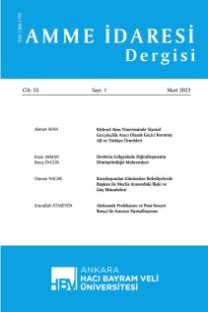Uluslararası Afet Müdahale Hukukuna Doğru Türk Afet Yönetim Sistemi
Türkiye
Turkey's Disaster Management System Towards International Disaster Response Law
Turkey,
___
- Agreement Among The Governments Of The Participating States Of The Black Sea Economic Cooperation (BSEC) On Collaboration In Emergency Assistance And Emergency Response To Natural And Man Made Disaster (1998) http://bsec-organization.org/temp/asistance.htm (25.06.2006)
- Agreement Establishing the Inter-Governmental Authority on Development (1996) http://www.iss.co.za/af/RegOrg/unity_to_union/ pdfs/igad/AgreementEstab.pdf (25.06.2006)
- Council of Europe Regulation No 1257/96 of 20 June 1996 Concerning Human Aid www.slovakaid.mfa.sk/en/index.php/filemanager/ download/41/Council%20Regulation%201257_96.pdf (25.06.2006)
- Darcy, James (2004), “Locating Responsibility: The Sphere Humanitarian Charter and its Rationale”, Disasters, 28 (2): 112- 123.
- Dufour, Charlotte, V. Geoffney, H. Maury; F. Grüneward (2004), “Rights, Standards and Quality in Humanitarian Space: Is Sphere Right Tool?”, Disasters, 28 (2): 124-141.
- Ergünay, Oktay (1999), “Afet Yönetimi Nedir? Nasıl Olmalıdır?”, Türk Psikoloji Bülteni-Deprem Özel Sayısı, V, 14. http:www.psikolog.org.tr/bulten/14/14.Afet_htm
- EU Council Decision of 23 October 2001 Establishing a Community Mechanism to Facilitate Reinforced Cooperation in Civil Protection Assistance Interventions, http://ec.europa.eu/environment/civil/prote/ cplegis/301d0792_en.htm (25.06.2006)
- Framework Convention on Civil Defense Assistance (2000), http://www.icdo.org/pdf/org/act-coop-frame-work-convention-en.pdf (25.06.2006)
- Gostelow, Lola (1999), “The Sphere Project: The Implications of Making Humanitarian Principles and Codes Work”, Disasters, 23 (4): 316-325.
- Hilhorst, Dorothea (2002), “Being Good at Doing Good: Quality and Accountability of Humanitarian NGO’s”, Disasters, 2002, 26 (3): 193-212.
- International Federation of Red Cross and Red Crescent (2000) “Towards an International Disaster Response Law”, World Disaster Report 2000.
- Katoch, Arjun (2006), “The Responders Cauldron: The Uniqueness of International Disaster Response”, Journal of International Affairs, spring, 2006: 59, 2: 153-172.
- Kreimer, Alcira (1990), Lessons Learned From Emerging Leading, The World Bank Environmental Department Divisional Working Paper No: 1990: 15.
- Kent, Randolph C. (2004), “The United Nations Humanitarian Pillar: Refocusing the UN’s Disaster and Emergency Roles and Responsibilities”, Disaster, 28 (2): 216-233.
- Lisler, Susan (2001), “Scaling-up Emergencies: British NGOs after Hurricane Mitch”, Disaster, 25 (1): 36-47.
- “Nükleer Kaza ve Radyolojik Tehlike Durumunda Acil Yardım Sözleşmesi”, http://www.msb.gov.tr/asad/AskeriMevzuat/Uluslarras%C4% B1%20Antla%C5%9Fmalar/Silahl%C4%B1%20%C3%87at%C4% B1%C5%9Fma%20Hukuku/SCH16.htm(07.06.2006)
- Mitchell, John, Deborah Doane (1999), “An Ombudsman for Humanitarian Assistance?”, Disasters, 23 (2): 115-124.
- O Donnell, Max. R, Dimitri Bacos, Michael L. Bennish (2002), “Nutritional Response to the 1998 Bangladesh Flood Disasters: Sphere Minimum Standards in Disaster Response”, Disasters, 26 (3): 229-241.
- Öztarhan, Meral (2004), Olağanüstü Hal Haberleşmesi, Ülke İhtiyaçları ve Tampere Sözleşmesi”, (Uzmanlık Tezi), Telekomünikasyon Kurumu, http://www.ifrc.org/docs/pubs/disasters/WDR2000.pdf (29.05.2006)
- Perry Ronald W, M. K. Lindell (2003) “Preparedness for Emergency Response Guidelines for the Emergency planning Process”, Disasters, 27 (4) 3336-350.
- Slim, Hugo (1997), “Doing The Right Thing: Relief Emergencies Moral Dilemmas and Moral Responsibility in Political Emergencies and War”, Disaster, 21 (3): 244-257.
- “Sphere Handbook”, http://www.sphereproject.org/content/view/ 27/84/lang,English/ (02.02.2006)
- Stephenson, Max. (2005), “Making Humanitarian Relief Networks More Effective Operational Coordination, Trust and Sense Making”, Disasters, 29 (4): 337- 350.
- Strengthening the Effectiveness and Coordination of International Urban Search and Rescue Assistance UN General Assembly Resolution 57/ 150 (2002), http://www.reliefweb.int/rw/hlp.nsf/db900ByKey/ GA57153?OpenDocument (25.06.2006)
- “Uluslararası Sivil Havacılık Sözleşmesi”, http://www.dhmi.gov.tr/ dosyalar/baskanliklar/Ozelguvenlik/Mevzuatlar.asp (07.06.2006)
- Walker, Peter (2005) “Creaking the Code: The Genesis, Use and Future of the Code of Conduct”, Disasters, 29 (4), 323-336.
- Walker, Peter, Susan Purdin (2004), “Birthing SPHERE”, Disasters, 2004 28 (2): 100-111.
- Waugh William L., Gregory Streib (2006), “Collaboration and Leadership for Effective Emergency Management”, Public Administration Review, Dec. 2006, Special Issue.
- Wu, Ying Jie, Michael K. Lindell (2004), “Housing Reconstruction after Two Major Earthquakes: The 1994 Northridge Earthquake in United States and the 1999 Chi-Chi Earthquake In Taiwan”, Disasters, XXVIII, 1: 63-81.
- Young, Helen, Paul Harvey (2004) “The Sphere Project: The Humanitarian Charter and Minimum Standards in Disaster Response: Introduction”, Disasters, 2004, 28 (2): 99-99.
- Young, Helen, Anna Taylor, Sally-Anna Way, Jennifer Leaning (2004) “Linking Rights and Standards: The Process of Developing “Right-Based” Minimum Standards on Food Security, Nutrition and Food Aid”, Disasters, 2004, 28 (2): 142-159.
- ISSN: 1300-1795
- Yayın Aralığı: 4
- Başlangıç: 1968
- Yayıncı: -
Yeni Örgütlenme Yaklaşımı Arayışında Karmaşık Sistemler
Türkiye'de E-İmza Altyapısı ve Kamu Kurumlarında Uygulamalar
Türksel Kaya BENSGHIR, Ferda TOPCAN
Behlül ÜSDİKEN, Özlem ÖKTEM YILDIRIM
Kamu Kurumlarında Bilgi Teknolojilerinin Kullanımda Yaşanan Sorunlar: Konya Kaymakamlıkları Örneği
Uluslararası Afet Müdahale Hukukuna Doğru Türk Afet Yönetim Sistemi
Eyyup Günay İŞBİR, F. Neval GENÇ
Türkiye'de İnternet Kafeler: İnternet Kafeler Üzerine Üretilen Söylemler ve Mekan-Kullanıcı İlişkisi
FERRUH MUTLU BİNARK, Günseli SÜTÇÜ BAYRAKTUTAN
Yetişkin Kadın Eğitimi Sorunsalı: Sultanbeyli'nin Yoksul Kadınlarının Eğitim Analizi
Ayşe ALİCAN, Aysun DİNEK, Songül GÜL SALLAN
Yetişkin Kadın Eğitimi Sorunsalı: Sultanbeyli'nin Yoksul Kadınlarının Eğitim Analizi
